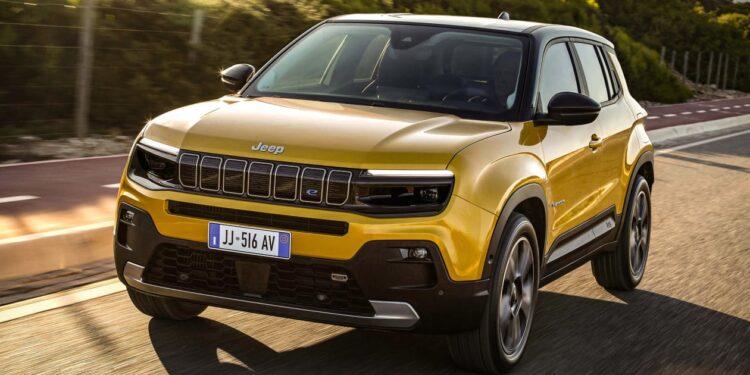The new Jeep Avenger has been unveiled and it’s the first fully-electric car from the iconic American brand. It’s also the first of Jeep’s four-strong lineup of new EVs, which will include the luxury-focused Wagoneer S and the rugged Recon.
Conceived, designed and engineered in Italy, the Avenger is a compact SUV that’ll rival everything from Stellantis sister vehicles like the Peugeot 2008 and Vauxhall Mokka to the Smart #1, Hyundai’s Kona and Ford Puma. It’s just under 4.1 metres long, so it will be the baby in Jeep’s line-up, beneath the Renegade and Compass. It is aimed squarely at European customers and while it will be sold in a few other territories, including a couple of countries in North Africa, there are presently no plans for it to be offered in North America.
The Avenger sits on an evolution of parent group Stellantis’s e-CMP platform, called e-CMP2. This new architecture has a number of key differences from the tech that underpins the current 2008, Mokka, and DS 3. Input from Jeep has helped to shorten its car’s front and rear overhangs, improving its potential for off-roading. It sits higher than any previous CMP model, with at least 20cm of ground clearance.
A four-wheel drive version will come in the form of a 4Xe model – previewed by the 4×4 Concept. Jeep hasn’t confirmed what will power the 4Xe variant. The concept not only has a wider track and larger wheel archs housing all-terrain tyres but the approach and departure angles have been improved. It’s not known how much of the concept’s off-road ability will be offered on the production car.
The overall look of the regular Avenger is predictably chunky – but the design team, which had the brief of “fitting 100 per cent of the brand DNA into four metres”, has done a good job of making its offering clearly a Jeep, and different from other CMP-based models. There’s a wide, planted-looking stance and at the front, an evolution of the Jeep seven-slot front grille that’s now flush to emphasise the car’s electric powertrain. Jeep plans to offer customisation of this part – everything from graphics to illumination. The side profile features a ‘kick’ at the C-pillar, like many larger Jeeps, and the rear has a fresh take on the ‘X’ tail-lights. This motif has also been adopted on surfaces inside the vehicle.
Other rugged features include lights that are set back into their mouldings, for extra protection, and underbody skid plates that are made from a coloured material instead of being painted and thus more prone to scrapes and scuffs.
The Avenger features the latest version of Stellantis’s electric powertrain because in all but a couple of European countries, it is designed to be a pure-electric offering only. The battery capacity is 54kWh (51kWh usable), comprising 10 cell modules in the rear of the car (beneath the back seats, basically) and seven modules under the front seats.
Elements including a heat pump and a three-phase 11kW AC charger will be standard across the range, along with 100kW DC charging that can take the car from 20 to 80 per cent of charge in 24 minutes.
The Avenger is being introduced in front-wheel-drive form, with a single motor producing 154bhp and 260Nm of torque. Jeep hasn’t released any performance figures yet, but it says the more efficient set-up will be capable of taking the 1,541kg vehicle up to 408km (254 miles) between charges on the WLTP test cycle, and as much as 550km (342 miles) in slower, stop-start city situations.
Regardless of the initial front-drive layout, Jeep says the car is as capable off road as some of its stablemates – with better approach, breakover and departure angles than the larger Renegade. The suspension configuration is MacPherson struts at the front and a twist beam at the rear, though this is likely to change to a multi-link affair for four-wheel-drive editions. The car features hill descent control and six driving modes to help with efficiency and poor conditions – eco, normal, sport, sand, mud and snow.
An internal-combustion engine Avenger has been spotted testing as well. The only visual tweaks that are noticeable on the test car are the revised grille, single-exit exhaust and the lack of Jeep’s ‘e’ badging. We expect it will borrow the commonly-used Stellantis turbocharged 1.2-litre three-cylinder Puretech engine with around 110bhp.
Inside, there are up to 34 litres of storage space in the cabin itself, and the boot capacity is 380 litres. Based on our experience with a static display model, the car has a little more rear-cabin space than the Mokka, and decent headroom for six-footers – although an optional panoramic sunroof might make the Avenger less generous on this score.
There’s a single size of infotainment screen – a 10.25-inch affair that features an Android-based operating system, and wireless smartphone hook-ups for both that OS and Apple CarPlay, but TomTom-based built-in navigation. There’s a fully digital instrument panel on all models too, although it will be seven inches in size on lower-end editions, and 10.25 inches further up the range. The other dashboard controls look clean and uncluttered, with simple drive-selector switches at the bottom of the centre console and a row of conventional buttons for heating and ventilation above them.
Jeep is launching the Avenger with a choice of seven paint colours and alloy wheels ranging in size from 16 to 18 inches. The car’s line-up will feature Jeep’s usual three trim levels – Sport, Longitude and Limited – although the company has yet to specify equipment lists for these versions. There’s likely to be a fully laden First Edition during the first few months of right-hand-drive sales too, based on Limited spec but with exclusive alloy wheels and flashier interior trim.
Customers will also be able to customise their cars extensively through their dealership. Around 100 accessories will be available, including graphics for everywhere from the roof to the bonnet and the flanks, designed to ensure that no two Avengers will be exactly the same.
Jeep is being coy on UK pricing for now; the car, which will be built alongside a forthcoming Alfa Romeo baby SUV at the Tichy plant in Poland, won’t go on sale here until the end of December, and first deliveries aren’t likely until summer 2023. But based on the initial price for the First Edition in European countries with EV incentives, that range-topper could cost around £36,000 in the UK, with entry-level Sport versions of the car coming in at around £30,000.
What does the new Avenger have to beat? These are the best electric SUVs on sale right now…


